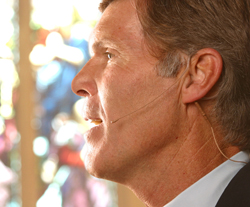
Typical placement puts the capsule about 8 inches under the chin, while actors usually hang/attach it just below the hairline.
The cable routes through the hair and down to a hidden transmitter. Most mics intended for this type of application are sweat-resistant.
Either placement creates potential problems, because the mouth radiates high frequencies straight out, but not so much downward or upward. As a result, vocal sound reaching the mic can be weak in the high frequencies.
To compensate, the frequency response is designed with a rise at high frequencies to compensate, typically a 5 to 6 dB peak from 6 to 10 kHz. That peak can be created by a resonant cavity in a press-on grille, which boosts the highs without adding noise as EQ can do.
Most lavs also roll off the low end below the voice range to reduce handling noise and pickup of air-handling rumble.
Chest placement also causes a small, narrow boost in the voice frequencies at about 730 Hz. Shure addressed this issue with a corresponding dip filter in the now-discontinued SM84 to correct the coloration, resulting in a more natural sound. The same thing can be achieved via mixing console EQ on the mic’s channel.
Additional Factors
Lavs typically have unidirectional or omnidirectional polar patterns.
A uni (cardioid) pattern reduces feedback and background noise, but is sensitive to cable noise, wind, and breath pops. It’s a good choice if the ambient noise level is high.
An omni generally sounds more natural and is smaller. It allows more head movement without level variations, and is less sensitive to cable noise, wind noise and pops.
In critical situations, it’s common practice to use redundant lavalier mics, two mics on a single clip, so that if one fails, there’s a back-up. If a lav must be hidden under clothing, it’s noise pickup can be minimized by wrapping the mic in a foam cylinder. Some high-frequency EQ boost may be needed to compensate for the muffling effect of clothing.
If the application has lavs on several people, such as a group discussion, an automatic mic mixer comes in handy. As the name suggests, it automatically turns off all mics except the one in use, giving a much clearer sound with less feedback. Examples of automatic mixers include the Dugan Sound Design Model E-1A and E-3, Shure SCM810 and Rane AM2.
Several accessories for lavs are available, including a variety of mounting clips and foam windscreens. A dual clip secures (“traps”) the cable twice, forming a “U” in the cable to reduce rubbing sounds.
In addition, Rycote offers undercovers, overcovers and stickies, which are disposable adhesive pads that reduce clothing rustles and wind noise.
Whether using lavalier or headworn mics, great results can be attained through using the right tool for the job and following the practices outlined here.
A member of AES and SynAudCon, Bruce Bartlett is a live sound and recording engineer, microphone designer (www.bartlettmics.com), and audio journalist. His latest book is Practical Recording Techniques, 6th Edition.


